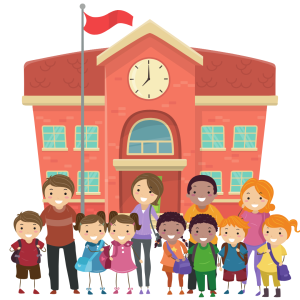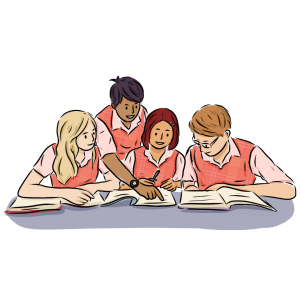Pediatrics
What you will find on this page:
While migraine can be debilitating and stressful, we need to work together to inform educators on the facts of migraine and the role they play in supporting children (of all ages) to be successful living with a chronic condition. The goal should be to work together as a team and create an environment for children to manage their pain and minimize disruptions and maximize their education. It is important to promote healthy pain-coping behaviors and inform educators the important role they play.

A Student’s Support Team
Parents
Parents have a critical role in educating teachers and administrators about their child’s diagnosis and prescribed treatment plan. It is important to have meetings on a regular basis, to share factual information from credible resources and be an advocate.
Parents can also help children advocate for themselves. It is important for a child to be able to describe their pain to their teacher(s) and advocate for the care they deserve.
Health Care Providers
Your child’s healthcare provide can also play a role. Having a letter of support from your child’s doctor or neurologist that includes information on diagnosis and prescribed medications may be helpful in informing the teacher and administration of your child’s unique and personal situation.
Your doctor can outline several courses of action in case of a migraine attack—such as taking over-the-counter or prescribed medications at the first sign of symptoms. Doctors can also help by advising of appropriate accommodations to be implemented at school to help children manage their migraine symptoms.
School Administrators
Your child’s teachers and administrators play a critical role in supporting your child. It is paramount you proactively provide your child’s teacher and school administration with information on migraine (we have developed a short pediatric fact sheet). It’s important to inform educators on the debilitating symptoms of migraine, as well as your child’s specific diagnosis. Referring them to Migraine Canada™ website is a great resource.
You should plan regular meetings to discuss your child’s situation, prescribed treatment plan and helpful accommodations that should be implemented. Emphasis should be made on the importance of administering medication as soon as your child begins to feel the onset of a migraine and that acute medication must be taken VERY QUICKLY to prevent worsening and a prolonged headache and helpful accommodations (somewhere quiet and dark to rest after taking medication). With successful early treatment of a migraine attack, the goal is to return to school activities after this time.
Explore Our Medical Letter Templates
Migraine Canada™ has collaborated with leading Canadian Pediatric Neurologists to develop medical notes you can have your child’s healthcare provider complete. The letters below are intended to act as an official medical note related to the medication and dosing that has been prescribed to treat your child’s migraine attacks. The notes include why it is important for medication prescribed by the healthcare professional to be administered at the onset of the attack.
Included below are PDFs you can print and have your HCP complete at your next appointment OR a fillable PDF that you can have your HCP pull up on their computer and fill out digitally, print and sign.
It’s important that either letter is dated and signed.
NOTE: The note that includes information on the type of accommodation a student should be given is more suitable for high school students but provides an option based on your situation.
Explore our Student Checklists
Pediatric Dosing Guide

Migraine Canada™ has collaborated with leading Canadian Pediatric Neurologists and pharmacists to develop a reference document on Therapeutic Management of Acute Migraine Attacks for children aged 6-17 years of age. We encourage you to download this information and share it with your clinician to optimize management of your child’s condition. When your child is 18 years of age he/she will be managed with adult dosing.

Pediatric Migraine
Know the Facts
Migraine does not discriminate:
2% of children under 6 years old have migraine (approximately 1 child out of 40).
4 to 11% of children from 6 to 11 years old have migraine (approximately 1 child out of 15).
8% of boys and 23% of girls from 12 to 17 will have migraine (close to 1 teenager out of 7).
For about 50% of adults suffering from migraine, the first attack occurred before the age of 20.
Close to 8% of children have migraine. Migraine may start early in childhood with an average onset around 7 for boys and 10 for girls.
Often an attack is easy to recognize (particularly for a parent). The child’s face may be pale or appear flushed, their eyes may appear sunken, and they may appear fatigued. It is also common for children to experience changes in their mood during an attack (e.g., irritability, feeling more anxious) and in their interaction with the environment (e.g., avoiding light and sound). It is common for children to stop playing and ask to lie down or to be alone during an attack. They may also express that they are having a headache, and they may vomit or feel nauseous.
The duration of children’s attacks is typically shorter than those of adults. Sometimes, it is over in 2 hours, but some attacks can last for days or longer. The duration and intensity can be reduced if treated effectively and treated early.
When attacks are not treated early and effectively, they can worsen, sometimes rapidly, last longer and may not respond to well to medications. Typically, untreated attacks will progress to more severe pain, and sometimes more severe associated symptoms like nausea, vomiting, sensitivity to light and sensitivity to sound. Some children may experience episodes of profuse and repeated vomiting, abdominal pain, or severe vertigo. While all these symptoms can occur with attacks of migraine, in some cases, the vomiting, abdominal pain, or severe vertigo can occur without prominent headache. These episodes are considered by specialists as conditions related to migraine (these syndromes are called: cyclic vomiting, abdominal migraine and benign positional vertigo).
Children with migraine report significantly lower quality of life compared to the quality of life of those not suffering from migraine.
Migraine can significantly impact school participation in different ways for each child. In particular, migraine can impact attendance, ability to concentrate, and ability to focus on schoolwork for an extended period of time. Some research has shown that children with migraine have lower academic performance compared to peers.
Support from educators and school staff can be helpful:
Appropriate accommodations should be put in place to ensure a successful school year.
Some people may require flexibility for deadlines, extended periods of time for tests, and a quiet space during the school day to take a break or rest.
If a student has missed school, they should be supported to help them to catch up at their own pace.
Be kind, patient, and sympathetic.
When a child reports having a headache, they should be believed and support should be put in place.







